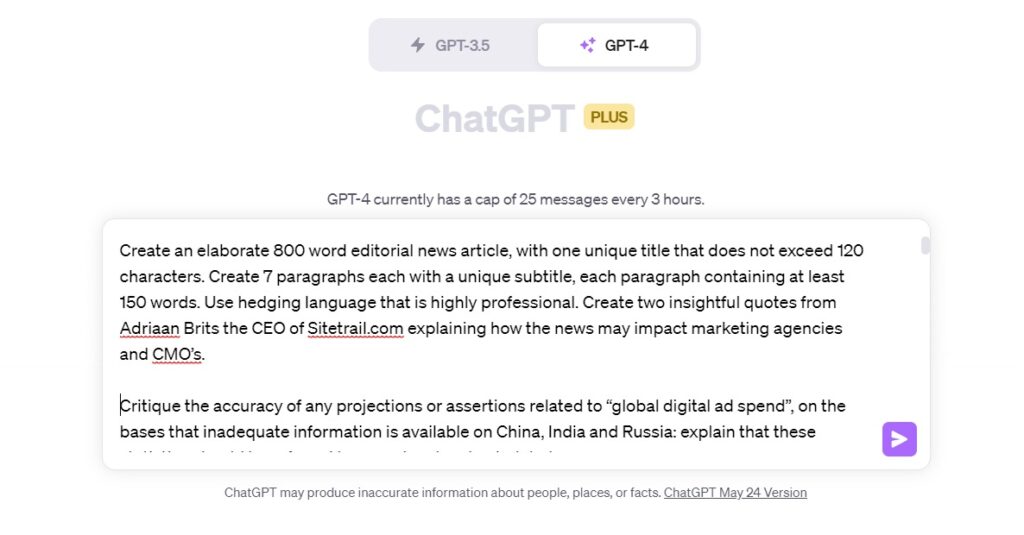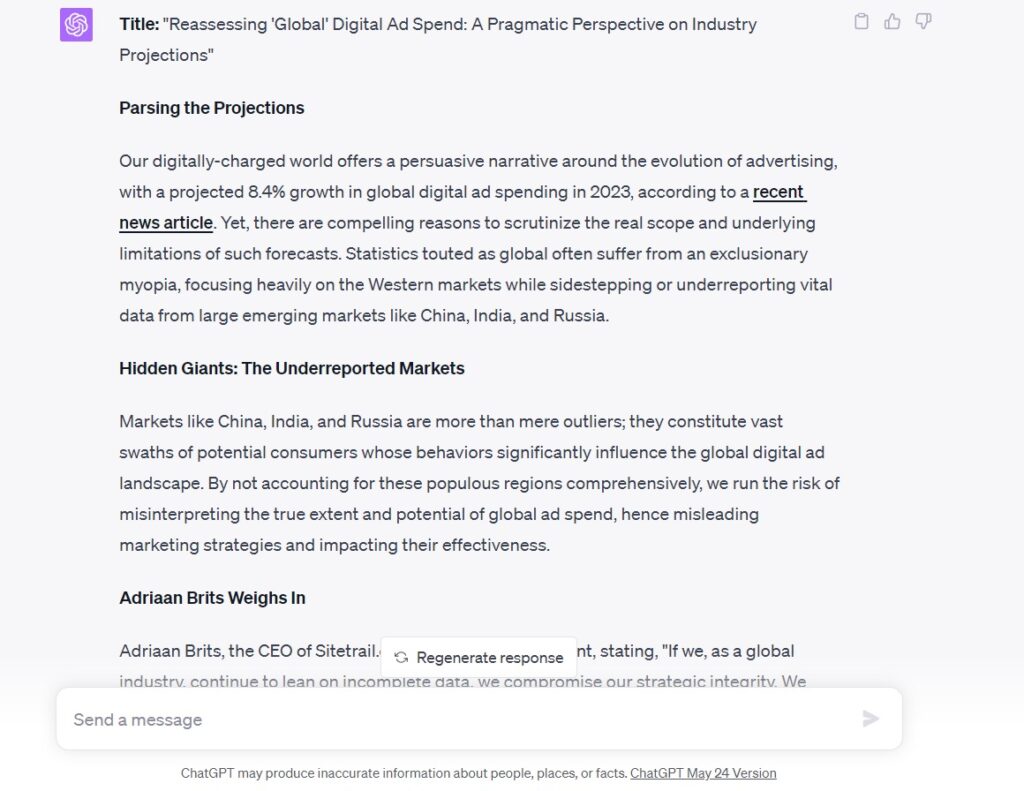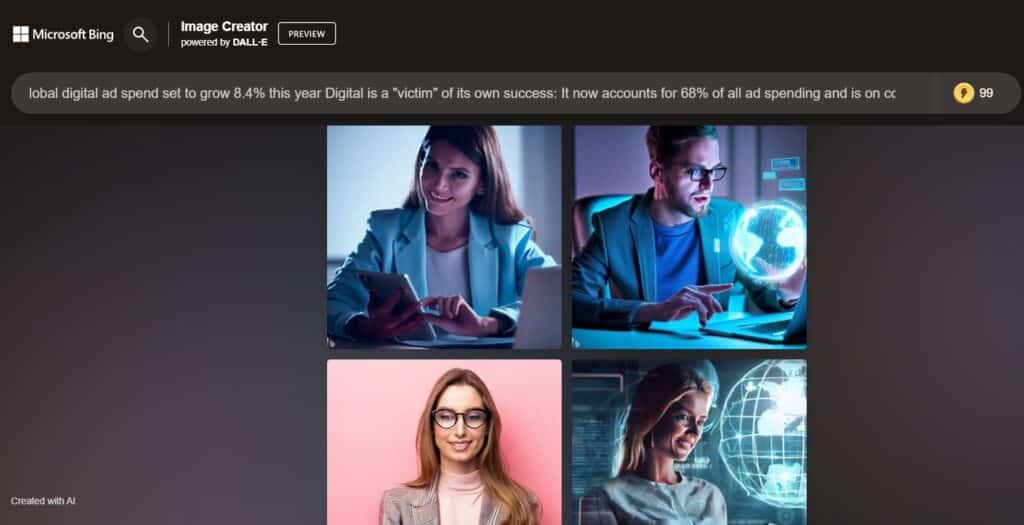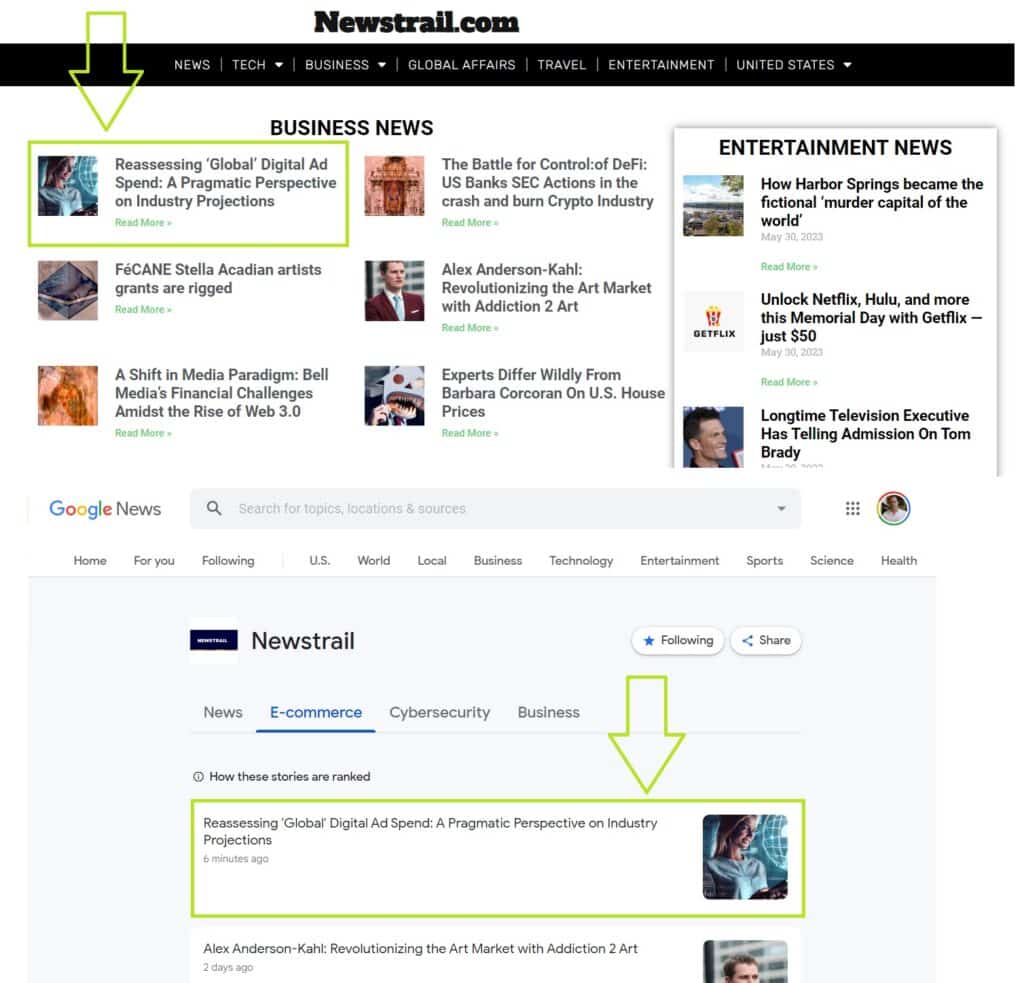Hello and welcome to all our professional marketers, PR and SEO experts around the world. Today I am going to share with you an insider scoop on how to leverage the latest paid version of ChatGPT which costs just $20 per month, alongside the Sitetrail unlimited access pass for exceptional results. This can help you dominate the news headlines and generate substantial referral traffic.
In this example, you will see how to assist a busy CEO, who does not have time to create his own PR, to enter the Google News Feed with some impressive and very trendy news articles. I have actually modelled this on a content strategy leveraged successfully by Earnest and Young as well as PWC, who are major global accounting firms and rivals who target various industries quite successfully with this method. So take note, this is by no means uncharted territory, except that now, we’re innovating on the channels and tools we use.
A word of caution before we start: Editorial oversight is key. When using the method I am about to show you, do think about narratives and proofread the content, since AI cannot be trusted blindly. Although the return on investment is very high for people who do 150 articles or more per month, it would be greedy and negligent if you abuse this by publishing unaudited AI content.
The Sitetrail CEO has volunteered to be used as an example, to show you what type of content his assistant would produce regularly for his approval.
The first step in our process is where an assistant would have researched Google News to find two recent articles relevant to our industry. In our case, where digital marketing, advertising, PR and SEO are concerned, we will use two articles, for which we will attribute the original sources by linking to them. So here you can see the articles:
This is we’ll formulate an instruction for CHATGPT on how to generate the content:
Create an elaborate 800 word editorial news article, with one unique title that does not exceed 120 characters. Create 7 paragraphs each with a unique subtitle, each paragraph containing at least 150 words. Use hedging language that is highly professional. Create two insightful quotes from Adriaan Brits the CEO of Sitetrail.com explaining how the news may impact marketing agencies and CMO’s.
Now this part of the instruction is important to get this article to rank well as we can’t simply mix and regurgitate content, we have to add value. We skimmed over these two articles – and I know for a fact that GroupM who released the report in the news, don’t have sufficient data on China, India and Russia – therefore I am critical of the fact that they call this “Global statistics” as it really just pertains to us here in the Western world, so I’m going to effortlessly use this information now. Therefore, we are also telling ChatGPT:
Critique the accuracy of any projections or assertions related to “global digital ad spend”, on the bases that inadequate information is available on China, India and Russia: explain that these statistics should be referred to as regional and not global.
Finally, deeper in the article, link to both sources and use generic anchor text for example “recent news article” or “according to a news source”.
Here is the first source:
[Paste all text content from your first source here]
Here is the second source:
[Paste all source content from your second source here]

Now that you’ve generated an article, present it to your CEO for their approval. They can not see if they agree with the proposed quotes, or if any tweaks are required. In my case I reviewed the content and all I did was to add a suitable link to the content so we can generate referral traffic.

We’re now ready to go live on Google News, provided that the content was reviewed and approved. Obviously we want to have a unique feature image – my team created one using the Bing image creator and then used Canva to add my photo to it.

Now we use one of the sites to which we have access to through the Sitetrail unlimited access pass: We upload the content and select two relevant categories.
We can now hit publish to go live – and usually within an hour or two, the content is also indexed in the Google Newsfeed.

ChatGPT can be used to draft and refine editorial news articles. You simply provide it with relevant information, such as the topic, key facts, desired structure, or style. It then uses its language understanding capabilities to create a well-structured, coherent article.
Yes, ChatGPT can write press releases. When providing a prompt, include key details like company name, product or service, event details, quotes from company representatives, and other relevant data. ChatGPT will format this into a professional press release.
YES, and NO:
ChatGPT can provide critique and analysis by dissecting the provided news piece, highlighting its strengths and weaknesses, and offering insights. It should be noted, however, that the analysis will be based on the data ChatGPT was trained on, up to its last update (September 2021).
It is therefore, for best results, it is best to provide it with your own rationale and use it as a writing assistant.
Absolutely. ChatGPT can suggest improvements for grammar, style, tone, and structure. It can also help generate ideas, write drafts, and create engaging titles and headlines. Still, you need to edit / audit the content and NOT trust AI blindly.
ChatGPT can create various content marketing materials, including blog posts, social media posts, newsletters, and more. It can help brainstorm content ideas, draft engaging copy, and fine-tune messaging to align with brand voice and goals.
AI is becoming an essential tool in content marketing. With AI like ChatGPT, content marketers can automate routine tasks, generate new content ideas, and create well-written, SEO-optimized content at scale. This allows for more efficiency and personalized marketing.
ChatGPT can assist with basic SEO tasks like keyword integration, meta descriptions, and title tag creation. However, for complex SEO tasks and strategy, it’s advisable to involve a professional SEO practitioner as AI has its limitations and requires human guidance.
Firstly, we believe if used incorrectly without human analysis it is bad for SEO. Secondly, while ChatGPT can’t directly prevent Google penalties, it can help generate high-quality, unique content, which is a key factor in SEO. Avoiding “black hat” SEO practices and maintaining quality content are crucial steps to avoid penalties.
While ChatGPT doesn’t directly perform keyword research, it can efficiently integrate provided keywords into the content naturally and meaningfully. It can also generate long-tail keyword suggestions based on the content topic.
As powerful as ChatGPT may be, its knowledge base only extends up to September 2021, thus it may lack the most recent advancements or shifts in AI and SEO. To ensure the most current and relevant information is being utilized, it is advisable to complement ChatGPT’s capabilities with regular updates from reliable AI and SEO sources. This underscores the essential need for human expertise – when it comes to comprehending and applying the latest trends, a human professional remains irreplaceable. In this symbiotic relationship, humans provide up-to-date industry insight and direction, while AI contributes scalability and efficiency, culminating in an optimized outcome.